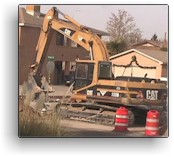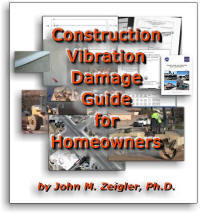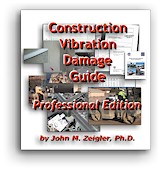|


| |  If you have construction, e.g. road work or development, starting, especially within 100 feet of your home, there are some things that it would be wise to do to protect yourself and your
investment in your home. This is especially true if
the construction company and/or the project sponsor have a record of causing construction damage on past projects. Depending on the type of work, the way it is being done and how vibrations
move through the soil in your locale, there may be reason for concern for any construction close enough to hear. Just below, you'll find a quick list of first steps for the homeowner who may have construction-caused
damage. The
Checklist section of this chapter provides a hyperlinked quick summary of the steps that most homeowners will have to take in pursuing a claim to resolution. Even if you're in a hurry, you will also want to be sure to read the
CVDG Intro, which has an overall, relatively short, summary of the CVDG content. If you have construction, e.g. road work or development, starting, especially within 100 feet of your home, there are some things that it would be wise to do to protect yourself and your
investment in your home. This is especially true if
the construction company and/or the project sponsor have a record of causing construction damage on past projects. Depending on the type of work, the way it is being done and how vibrations
move through the soil in your locale, there may be reason for concern for any construction close enough to hear. Just below, you'll find a quick list of first steps for the homeowner who may have construction-caused
damage. The
Checklist section of this chapter provides a hyperlinked quick summary of the steps that most homeowners will have to take in pursuing a claim to resolution. Even if you're in a hurry, you will also want to be sure to read the
CVDG Intro, which has an overall, relatively short, summary of the CVDG content.
First Steps -
Every Second Counts
When you first discover damage to your home or building, which you believe or know was caused by nearby construction vibration, you will have a lot do in the minutes and hours immediately following the
discovery. The ultimate outcome of your claim will depend to a great extent upon what you do the first day after you discover vibration damage.
First, you must document the existing damage as quickly as possible. Because even a few minutes can be important if construction with heavy equipment is still
ongoing, do an initial quick survey for damage instances, photographing or videotaping as you go. You can return a few hours later for a more complete and exhaustive survey. Because more damage will likely appear in the weeks and
months subsequent to your discovery of the first damage, you should resurvey the damage occasionally to record the developing examples.
You also MUST start immediately documenting on video and/or photos the construction itself, especially those
operations like vibratory compaction, pile driving, blasting and heavy equipment movement, which are known to be capable of causing damage in many circumstances. You should continue
to document the construction until it finishes in your immediate neighborhood. A smart phone will work just fine for video and photos initially, though a dedicated video camera may be more useful in the long term.
Once you have started all these processes, you need to inform without delay the contractor and the project
sponsor of the damage. The Reporting Damage chapter of both versions of the CVDG PDF gives you tips on how to do that most effectively. That report will trigger a nearly immediate set of damage inspections by the contractor's representatives and numerous others. If you have extensive damage, you will probably
want to contact an attorney to help you with interactions with all the people who will want to view the damage. It is wise to retain a vibration damage expert as early as possible to help you and your
attorney.
This section portrays a tiny part of the work that you will do to forward a legitimate vibration damage claim, but it is probably the most critical part.
When Seeking HelpMost people with vibration damage claims find that they need help to pursue compensation for the damages with recalcitrant construction companies and insurers. Whether that help comes from an attorney, an expert, or even us at
Vibrationdamage.com, there are some types of information that you should have available before you contact anyone for help:
the distance between your home or structure and the site of the work. For moving operations, the distance of closest
approach should be known. You can easily get the distances from Google Maps online or
Google Earth satellite photos. Having the distances allow the calculation of likely vibration velocities for your location and the type of job being done.
documentation of both the damage seen AND the construction operations which you believe might be responsible for the damage. Typically, this will be photos and video, but may include documentation of other sorts. If you
don't have all of this data, then provide a summary of the equipment types you have seen operating on the job.
any information you have regarding the funder of the work, any web sites which have useful information about the project - including ones on which you have placed documentation.
With knowledge of these factors, you should be able to get a fairly rapid reading on the likelihood of damage and its cause. Without it, you will spend more money and time than is necessary. You will need to do much more later as
your claim develops, but this information will be needed immediately and frequently during the course of your claim.
The Checklist Following is a short list, in approximate chronological order, of what you might need to do to prepare for
construction in your area or deal with damage after construction has begun, abstracted and highly
condensed from the content of the free Construction Vibration Damage Guide for Homeowners (CVDG free),
https://vibrationdamage.com/download.htm.
The links below point to the original CVDG chapters which discuss the topics mentioned in much greater detail. The CVDG Pro has comprehensive information for those with damage and those who
must address damage occurrences. The sooner you start the steps below, the more protection you will have
in the event that damage occurs:
- Document the condition of your home by photo or video, prior to construction start or as soon after construction start as possible. Be sure to document locations where damage is most
often found: corners of window and door wall penetrations, attached concrete slabs, and door frames.
If, at the same time, you document the contents of the home, you can also use the images for insurance purposes in the event of an unrelated loss.
- Find out all you can about the construction and the contractor from any public web sites which have relevant information. Print everything you find to
hard copy and/or PDF file. Attend any public
meetings prior to construction start.
- Prepare to document construction by photo or video. If you have security cameras, you can add or redirect one or more to do part of this job, although
security footage is not a complete substitute for your own photos or videos. You may also be able to use a
neighbor's security footage, if one or more cameras are pointed toward the construction.
- Document the construction as much as you can by video or photos. You can even use a cell phone, tablet computer or your existing security cameras for this. Pay particular attention to those days when
compaction and paving, demolition, pile driving or blasting may be done. Get photos and/or video of as many pieces of construction equipment in use as you can, making sure you
capture the equipment model designations.
- Get recordings of the largest vibrations for documentation, using just about any iOS or Android tablet or cell phone having accelerometer sensors, along with free vibration monitoring apps for your device. In the unlikely event that any
vibration monitoring is
done for the contractor, you may want to get those data ultimately. Having your own data on vibrations can often help you get seismograph data that would, otherwise, not be acknowledged or produced.
- Check your home regularly during the construction process for new or expanding cracks and other signs of damage, recording any changes on video or in photos. Pay particular
attention to diagonal cracks extending from the corners of wall penetrations. Also check for concrete and slab cracking. You should document any other forms of damage, as well.
- Assemble evidence of the pre-construction condition of the home - This can take the form of photos and video of any sort. Even if you have not documented the
condition of the home prior to construction start, any kind of evidence of the prior condition, especially where damage appears after construction, is useful and will be necessary as you pursue your claim
- Notify the contractor and the project sponsor as soon as possible of any damage which you believe can be directly associated with construction.
- Prepare for and conduct damage inspection visits by representatives of the contractor, insurers, project sponsors, etc.
- Contact an attorney, if your damage is sufficient and your case documented well enough to justify the cost.
- Talk to neighbors about possible damage in their homes. Document that damage with their permission.
- Talk with your attorney on an ongoing basis about other steps that you need to take.
More information describing how to carry out these steps can be found in the CVDG PDF, available for free download at https://vibrationdamage.com/download.htm, with
comprehensive information in the CVDG Professional Edition at https://vibrationdamage.com/cvdg_pro__overview.htm. It needn't take more than a few hours work to do all
the steps above, but it can
put you in a far stronger position if you experience damage.
|
  This is a chapter from the Construction
Vibration Damage Guide for Homeowners (CVDG), a 100+ page free
book with over 300 color photos, diagrams and other illustrations.
It is available at
https://vibrationdamage.com as a series of web pages or in full,
web navigation and ad-free,
as a downloadable PDF e-book, with
additional content not available on the web. The free
version of the CVDG is licensed to homeowners and others for
personal, at-home use only. A Professional Edition (CVDG Pro), licensed
for business use and with over three times as much content, can be ordered from our
Order the CVDG Pro page, usually with same-day delivery. You can comment about this page or ask
questions of the author, Dr. John M. Zeigler, by using our Visitor Comment
form. This is a chapter from the Construction
Vibration Damage Guide for Homeowners (CVDG), a 100+ page free
book with over 300 color photos, diagrams and other illustrations.
It is available at
https://vibrationdamage.com as a series of web pages or in full,
web navigation and ad-free,
as a downloadable PDF e-book, with
additional content not available on the web. The free
version of the CVDG is licensed to homeowners and others for
personal, at-home use only. A Professional Edition (CVDG Pro), licensed
for business use and with over three times as much content, can be ordered from our
Order the CVDG Pro page, usually with same-day delivery. You can comment about this page or ask
questions of the author, Dr. John M. Zeigler, by using our Visitor Comment
form.  If you would like to discuss vibration damage issues and view additional content not found in the CVDG, Join
us on Facebook. Please Like us while you're there. If you would like to discuss vibration damage issues and view additional content not found in the CVDG, Join
us on Facebook. Please Like us while you're there. |
| |
|



